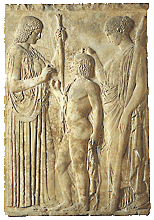The rite proper took place in the Telesterium: it was here that the hierophant
displayed the objects known simply as the 'sacred
things'. The ear of corn, Demeter's sacred plant, was one
of the nuclear symbols of the cult. Ritually harvested
every year by the female priest (or by some temple
servant), from the god's sacred field, it was kept safe
in the shrine, to be exhibited by the hierophant during
the culminating rite of the Eleusinian Mysteries - the
moment when it was announced that 'Brimo' had divinely
given birth to 'Brimus'. There are numerous views about
wthe identification of this mother and child. Were they
Persephone and Iacchus-Dionysus, perhaps? Demeter and
Pluto? As for the symbolism of the ear of corn, there is
general agreement that it had to do with the life-cycle
and the hope of a life after death. This symbolism was
recapitulated in the life-cycle of the corn itself. |
 |




